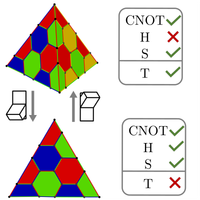Fault-Tolerant Code-Switching Protocols for Near-Term Quantum Processors
引用次数: 0
Abstract
Topological color codes are widely acknowledged as promising candidates for fault-tolerant quantum computing. Neither a two-dimensional nor a three-dimensional topology, however, can provide a universal gate set {h, t, cnot}, with the t gate missing in the two-dimensional and the h gate in the three-dimensional case. These complementary shortcomings of the isolated topologies may be overcome in a combined approach, by switching between a two- and a three-dimensional code while maintaining the logical state. In this work, we construct resource-optimized deterministic and nondeterministic code-switching protocols for two- and three-dimensional distance-three color codes using fault-tolerant quantum circuits based on flag qubits. Deterministic protocols allow for the fault-tolerant implementation of logical gates on an encoded quantum state, while nondeterministic protocols may be used for the fault-tolerant preparation of magic states. Taking the error rates of state-of-the-art trapped-ion quantum processors as a reference, we find a logical failure probability of 3% for deterministic logical gates, which cannot be realized transversally in the respective code. By replacing the three-dimensional distance-three color code in the protocol for magic state preparation with the morphed code introduced in Vasmer and Kubica [PRX Quantum 3, 030319 (2022)], we reduce the logical failure rates by 2 orders of magnitude, thus rendering it a viable method for magic state preparation on near-term quantum processors. Our results demonstrate that code switching enables the fault-tolerant and deterministic implementation of a universal gate set under realistic conditions, and thereby provide a practical avenue to advance universal, fault-tolerant quantum computing and enable quantum algorithms on first, error-corrected logical qubits.

近端量子处理器的容错代码转换协议
拓扑颜色编码被广泛认为是容错量子计算的理想候选方案。然而,无论是二维拓扑还是三维拓扑,都无法提供一个通用门集 {h、t、not},二维拓扑中缺少 t 门,三维拓扑中缺少 h 门。通过在二维和三维代码之间切换,同时保持逻辑状态,可以通过组合方法克服孤立拓扑的这些互补缺点。在这项工作中,我们利用基于标志量子比特的容错量子电路,为二维和三维距离三色码构建了资源优化的确定性和非确定性代码切换协议。确定性协议允许在编码量子态上实现逻辑门的容错,而非确定性协议可用于魔法态的容错准备。以最先进的困离子量子处理器的错误率为参考,我们发现确定性逻辑门的逻辑失败概率为 3%,而这在相应的代码中是无法横向实现的。通过用 Vasmer 和 Kubica [PRX Quantum 3, 030319 (2022)]介绍的变形代码取代魔态准备协议中的三维距离三色代码,我们将逻辑失败率降低了 2 个数量级,从而使其成为在近期量子处理器上进行魔态准备的可行方法。我们的研究结果表明,代码转换能在现实条件下实现通用门集的容错和确定性,从而为推进通用、容错量子计算提供了一条切实可行的途径,并使量子算法能够在第一个纠错逻辑量子比特上实现。
本文章由计算机程序翻译,如有差异,请以英文原文为准。
求助全文
约1分钟内获得全文
求助全文

 求助内容:
求助内容: 应助结果提醒方式:
应助结果提醒方式:


